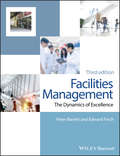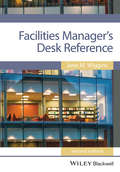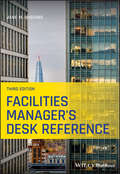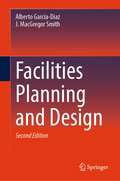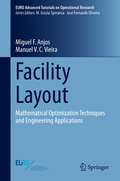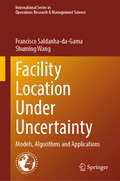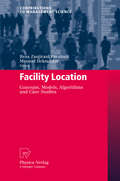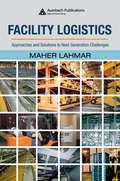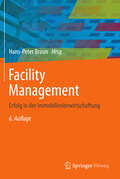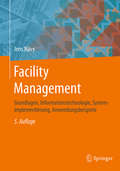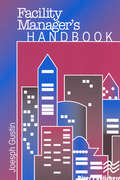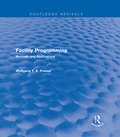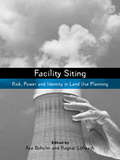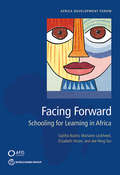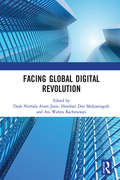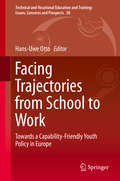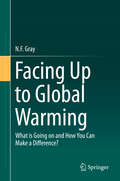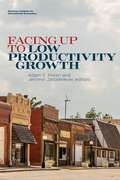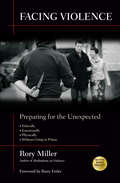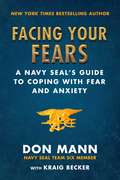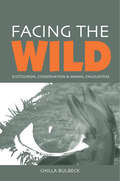- Table View
- List View
Facilities Management: The Dynamics of Excellence
by Peter Barrett Edward FinchFacilities management continues to expand and develop in terms of the volume and diversity of commercial activity, with a significant influence upon organisational success and goal achievement. The two previous editions of Facilities Management have become established as key sources for all facilities management courses and forward thinking facilities managers, providing a strong blend of research-informed opportunities and practical, balanced advice for strategically orientated practitioners. This third edition builds on those foundations, focussing on the driving idea that excellent facilities management demands a responsive and dynamic approach to the positive impacts facilities can have on users operating within a world in flux. Within this overarching theme the book considers numerous contemporary issues facing facilities managers, within a framework that covers organisation, technology and process.
Facilities Manager's Desk Reference
by Jane M. WigginsAn invaluable source of highly relevant, practical information on the all the principal FM services, written for the practicing facilities manager in an easily readable, concise format.To help the facilities manager meet the needs of their organisation, the Facilities Manager's Desk Reference provides the facilities manager with an invaluable source of highly relevant, practical information on the all the principal FM services, as well as information on legal compliance issues, the development of strategic policies and tactical best practice information. Fully updated over the first edition, and presented in an easily readable, concise format with a clear practitioner perspective, the book covers both hard and soft facilities management issues. It will be a first point of reference for all busy facilities managers, saving them time by providing access to the information needed to ensure the safe, effective and efficient running of any facilities function. Fully updated over the 1st edition, it contains all the essential data covering the principal FM servicesHighly practical, aimed at the busy FM practitionerSaves time by bringing together essential, useful and practical informationBenefits students whose courses do not prepare them for the practicalities of professional practice
Facilities Manager's Desk Reference
by Jane M. WigginsA practical guide to the principle services of facilities management, revised and updated The updated third edition of Facilities Manager’s Desk Reference is an invaluable resource covering all the principal facility management (FM) services. The author—a noted facilities management expert—provides the information needed to ensure compliance to current laws, to deliver opportunities to adopt new ways of using built environments, and to identify creative ways to reduce operational occupancy costs, while maintaining appropriate and productive working environment standards. The third edition is fully updated and written in an approachable and concise format. It is comprehensive in scope, the author covering both hard and soft facilities management issues. Since the first edition was published it has become a first point of reference for busy facilities managers, saving them time by providing access to the information needed to ensure the safe, effective and efficient running of any facilities function. This important book: Has been fully updated, reviewing the essential data covering the principal FM services Is highly practical, ideal for the busy FM practitioner Presents information on legal compliance issues, the development of strategic policies, tactical best practices, and much more Is a time-saving resource that brings together essential, useful, and practical FM information in one handy volume Written for students and professional facilities managers, Facilities Manager’s Desk Reference is designed as a practical resource that offers FMs assistance in finding solutions to the myriad demands of the job.
Facilities Planning and Design
by Alberto Garcia-Diaz J. MacGregor Smith(Deceased)This updated, expanded, second edition includes new software methodologies and algorithms providing students with a more comprehensive knowledge base in addition to facilitating and making the project component of the textbook more efficient and effective. It further increases emphasis on manufacturing. Retaining its class-tested pedagogy, the book is concerned with the principles of facilities planning and their application to service, business, and product manufacturing operations. Equipping undergraduate students with the fundamentals of facilities planning, design, location and material handling, especially as they apply to industrial manufacturing facilities, the book is ideal for a range of university settings offering courses on facilities planning.
Facility Layout: Mathematical Optimization Techniques and Engineering Applications (EURO Advanced Tutorials on Operational Research)
by Miguel F. Anjos Manuel V.C. VieiraThis book presents a structured approach to develop mathematical optimization formulations for several variants of facility layout. The range of layout problems covered includes row layouts, floor layouts, multi-floor layouts, and dynamic layouts. The optimization techniques used to formulate the problems are primarily mixed-integer linear programming, second-order conic programming, and semidefinite programming. The book also covers important practical considerations for solving the formulations. The breadth of approaches presented help the reader to learn how to formulate a variety of problems using mathematical optimization techniques. The book also illustrates the use of layout formulations in selected engineering applications, including manufacturing, building design, automotive, and hospital layout.
Facility Location Under Uncertainty: Models, Algorithms and Applications (International Series in Operations Research & Management Science #356)
by Shuming Wang Francisco Saldanha-da-GamaThis textbook provides researchers, post-graduate students, and practitioners with a systematic framework for coping with uncertainty when making facility location decisions. In addition to in-depth coverage of models and solution techniques, application areas are discussed. The book guides readers through the field, showing how to successfully analyze new problems and handle new applications. Initially, the focus is on base models and concepts. Then, gradually, more comprehensive models and more involved solution algorithms are discussed. Throughout the book, two perspectives are intertwined: the paradigm for capturing uncertainty, and the facility location problem at hand. The former includes stochastic programming, robust optimization, chance-constrained programming, and distributional robust optimization; the latter includes classical facility location problems and those arising in many real-world applications such as hub location, location routing, andlocation inventory.
Facility Location: Concepts, Models, Algorithms and Case Studies (Contributions to Management Science)
by Masoud Hekmatfar Reza Zanjirani FarahaniThis book deals with location problems. Location problems establish a set of facilities (resources) to minimize the cost of satisfying a set of demands (customers) with respect to a set of constraints. There are four components that describe location problems: customers, who are assumed to be already located at points or on routes, facilities that will be located, a space in which customers and facilities are located, and a metric that indicates geographical and chronological distances between customers and facilities. This book describes these parts in each specific location model. Location models are used in a variety of applications such as locating warehouses within a supply chain to minimize the average time to market, locating noxious material to maximize its distance to the public, etc. In this book, readers can find these applications exemplified by real-world cases for each particular model. The relationship between location problems and other areas such as supply chains is also considered here.
Facility Logistics: Approaches and Solutions to Next Generation Challenges (Engineering and Management Innovation)
by Maher LahmarThe design of facilities, warehouses, and material-handling systems as well as the management of logistics operations significantly impact the success of industrial projects. Facility Logistics: Approaches and Solutions to Next Generation Challenges explores recent developments in the technology, industrial practices, and business environments of f
Facility Management
by Hans-Peter Braun Martin Reents Peter Zahn Patrick WenzelHans-Peter BraunDer Management-Leitfaden zur Einf#65533;hrung und Umsetzung von Facility Management erscheint bereits in der 6. Auflage. Die Neubearbeitung der Themen reicht von der nachhaltigen Geb#65533;udebewirtschaftung #65533;ber die Problematik bei der Einf#65533;hrung einer elektronischen Geb#65533;udeakte, bis hin zur Produktionssteigerung mit Hilfe eines CAFM-Geb#65533;udeinformationssystems und tr#65533;gt damit dem heutigen Stand der Technik Rechnung. Das Buch gibt Antworten auf folgende Fragen: - Welchen Nutzen bietet ein nachhaltiges Facility Management? - Welche H#65533;rden gilt es bei der Umsetzung und Einf#65533;hrung zu beachten? - Wodurch werden Kosteneinsparungen erzielt? - Welche Hilfsmittel und Werkzeuge eignen sich am besten?
Facility Management: Grundlagen, Informationstechnologie, Systemimplementierung, Anwendungsbeispiele
by Jens NävyIndustrie- und Wohnungsunternehmen verwalten ihre Gebäude, Anlagen und Grundstücke mit Hilfe des Facility Management (FM). Dieses Buch informiert über die Informationstechnologie im FM. Das Computer Aided Facility Management (CAFM) bildet dabei den Schwerpunkt. Gegenüber der 3. Auflage sind die Marktübersicht und Ausführungen dazu aktualisiert. Der Autor betreibt selber beratend die Professionalisierung der Gebäude- und Immobilienbewirtschaftung.
Facility Manager's Handbook
by Joseph F. GustinThe "bricks and mortar" issues of facility management - HVAC, lighting, electrical, plumbing, space allocation, security and grounds maintenance - continue to be at the core the facility manager's role. However, the processes involved in addressing these areas have become more complex. The proliferation of regulatory mandates, worker compensation issues, increased employee litigation, and violence in the workplace have redefined the role of the facility manager beyond "gatekeeper" to that of full-scale operations manager. Today's corporations, organizations, and business partnerships invest heavily in their physical plants. It naturally follows that they expect to maximize the return on their investment. Facility managers are seen as the catalysts for ensuring that optimal return.The Facility Manager's Handbook addresses all of these issues, and provides a multitude of tested ideas, procedures and examples for successfully and cost-effectively managing facility operations. Written in a plain-language, reader-friendly style, it provides a panoramic view of the process by isolating the key areas the facility manager must address, including real estate, space and change management, indoor air quality, emergency preparedness and response planning, communications systems, regulatory mandates and more.
Facility Programming: Methods and Applications (Routledge Revivals)
by Wolfgang F. PreiserFirst published in 1978, the objective of this book is to provide an authoritative and selective overview of current, user-orientated programming methods within the field of environmental design. The 19 chapters compiled in this volume describe procedures and the information content of innovative approaches used by leading programming experts in the private and institutional sectors. Emphasis is placed on a qualitative and illustrative focus of selected approaches to environmental programming with the eventual occupants in mind. The chapter groupings are intended to reflect three major areas of professional engagement that serve the field of facility programming. The first group describe the approaches of firms or groups that were organised exclusively to provide environmental analysis and programming services. Part II is composed of chapters by authors who belong to established architectural firms with programming departments and Part III presents evidence that pertains to the supporting role of research and guidance literature from authors primarily affiliated with government agencies or supported by large organisations.
Facility Siting: Risk, Power and Identity in Land Use Planning (Earthscan Risk in Society)
by Åsa Boholm Ragnar E LöfstedtFrom dams to landfill sites, and power plants to radioactive waste repositories, the siting of facilities is a veritable minefield of conflicts involving industry, planners, authorities, NGOs and citizens. This penetrating volume examines risk, power and identity in contests over the siting of infrastructure and industrial facilities. Going beyond nimby-ism, experts in a variety of fields bring a multiperspective analysis from science, law and media to case studies from the UK, USA and Europe, and expose the political and cultural dimensions of siting conflicts. In the process they show how place attachment and notions of landscape and local identity play a prominent role in resistance to 'development'. Topics covered include the importance of context in siting controversies, siting methods and social representation, siting conflicts, the importance of institutional thinking in facility siting, risk, industrial encroachment and the sense of place, siting and sacred places, and law and fairness. This book is essential reading for academics in social sciences, policy, planning, law and risk; policy makers, planners and decision makers at all levels of government; business and industry, particularly energy generation, including nuclear and renewables, transportation and large dams; risk assessment professionals; and NGOs and activists.
Facing Crisis: The Source of Psychological Impasse
by Timothy ButlerYou can't overcome psychological impasse until you identify the source. To find that source, you must be willing to examine the feelings that come along with impasse, although that might be daunting. Once impasse is understood as a necessary crisis, it is possible to look at such tough times as opportunities to reclaim meaning in your daily life.
Facing Forward: Sage Advice from the Front Line, to the Front Line--Gaining Buy-In for Mass Career Customization
by Cathleen Benko Anne WeisbergMass career customization (MCC) is born out of the reality that today's workforce is highly nontraditional while today's workplace is not and that demand for talent will outpace supply for the next twenty or so years. Pioneers who see the proverbial writing on the wall are moving to create strategic and competitive advantage to distinguish themselves in the eyes of the talent they need to attract and retain. Leading your organization to adopt MCC will require a solid understanding and buy-in of the urgency regarding the supply-and-demand dynamics of the people part of the shareholder value equation. This chapter offers guidance on how to enlist MCC pioneers through a compelling business case and provides some straight talk about the difficulty of taking those first steps forward. This chapter is excerpted from "Mass Career Customization: Aligning the Workplace with Today's Nontraditional Workforce."
Facing Forward: Schooling for Learning in Africa (Africa Development Forum)
by Sajitha Bashir Tan Marlaine Lockheed Elizabeth NinanWhile everybody recognizes the development challenges facing Sub-Saharan Africa, few have put together coherent plans that offer real hope for any feasible and general improvement. Facing Forward combines an evidence-based plan that not only recognizes the deep problems but provides specific prescriptions for dealing with the problems. In the simplest version, focus on the skills of the people and do it in a rational and achievable manner. †“ Eric Hanushek, Paul and Jean Hanna Senior Fellow, Hoover Institute, Stanford University This book offers a clear perspective on how to improve learning in basic education in Sub- Saharan Africa, based on extremely rigorous and exhaustive analysis of a large volume of data. The authors shine a light on the low levels of learning and on the contributory factors. They have not hesitated to raise difficult issues, such as the need to implement a consistent policy on the language of instruction, which is essential to ensuring the foundations of learning for all children. Using the framework of “From Science to Service Delivery,†? the book urges policy makers to look at the entire chain from policy design, informed by knowledge adapted to the local context, to implementation. Facing Forward: Schooling for Learning in Africa is a unique addition to the literature that is relevant for African policy makers and stakeholders. †“ Professor Hassana Alidou, Ambassador of the Republic of Niger to the United States and Canada As the continent gears itself up to provide universal basic education to all its children by 2030, it has to squarely address the challenge of how to improve learning. Facing Forward helps countries to benchmark themselves against each other and to identify concrete lines of action. It forces policy makers to think “where do I go from here?†? “what do I do differently?†? and to examine the hierarchy of interventions that can boost learning. It rightly urges Ministries of Education to build capacity through learning by doing and continuous adaptation of new knowledge to the local context. Facing Forward will unleash frank conversations about the profound reforms that are required in education policy and service delivery to ensure learning for every child on the continent. †“ Dr. Fred Matiang’I, Cabinet Secretary for the Interior and Coordination of National Government, Government of Kenya (former Cabinet Secretary for Education) Facing Forward couldn’t have come at a more opportune time as countries in the region, including Mauritius, focus more on learning outcomes rather than simply on inputs and processes in education systems. The book underscores the important point that African countries need not exclusively model themselves on high-performing education systems in the world. Much can as well be learnt from other countries at the same level of development, or lower, by virtue of the challenges they have faced and successfully overcome. This presents opportunities for greater peer-sharing and networking with these countries. Indeed a number of key focus areas are highlighted in the book that demonstrate good practices worthy of being emulated. These cover domains as diverse as enabling factors leading to improved student progression, strengthened teacher capacity, increased budgetary allocation with a focus on quality, as well as improved technical capacity of implementing agencies in the region. †“ Hon. (Mrs.) Leela Devi Dookun-Luchoomun, Minister of Education and Human Resources, Tertiary Education and Scientific Research, Republic of Mauritius
Facing Global Digital Revolution: Proceedings of the 1st International Conference on Economics, Management, and Accounting (BES 2019), July 10, 2019, Semarang, Indonesia
by Dyah Nirmala Arum Janie, Hendrati Dwi Mulyaningsih, Ani Wahyu RachmawatiThe Industrial Revolution 4.0 describes the exponential changes to the way we live, work, and relate to one another due to the adoption of cyber-physical systems, the Internet of Things, and the Internet of Systems. This revolution is expected to impact all disciplines, industries, business, and economics. Therefore, the main goal of the conference was to provide recent research related development of digital technology to the business, economics, management, and accounting field. These proceedings consist of selected papers, accepted after a rigid review process covering several issues in strategic decision making, management, accounting, policy studies, knowledge management, innovation management, applied economics, econometrics, capital market, and marketing & sales management. It will provide details beyond what is possible to be included in an oral presentation and constitute a concise but timely medium for the dissemination of recent research results. BES Conference Proceedings 2019 will be invaluable to professionals and academics in business, management, accounting, and economics for a good understanding of the developments towards industrial revolution 4.0.
Facing Trajectories from School to Work
by Jean-Michel Bonvin Hans-Uwe Otto Roland Atzmüller Thierry Berthet Lavinia Bifulco Enrica Chiappero-Martinetti Valerie Egdell Björn Halleröd Christian Christrup Kjeldsen Marek Kwiek Regine Schröer Josiane Vero Marianna ZieleńskaThis book promotes a radical alternative impact on youth policy in Europe to overcome the situation of vulnerability and discrimination of a growing number of youngsters in their transition from school to work. It follows a Human Development perspective in using the Capability Approach (CA) as analytical and methodological guiding tool to improve the social conditions of the most socially vulnerable young people in European societies. The mission of the interdisciplinary authors is to expand the actual chances of the young to actively shape their lives in a way they have reason to choose and value. This book is based on the research of the EU Collaborative Project "Making Capabilities Work" (WorkAble), funded by the EU within the Seventh Framework Programme. It is the first empirical project to pursue a justice theory perspective on a European level. It also contributes to a fundamental change in the currently mostly insufficient attempts within the human capital approach to use the labour market to ensure desired lifestyle forms and a secure income for vulnerable youth.
Facing Up to Global Warming
by N. F. GrayIn this volume, Professor N. F. Gray offers a comprehensive primer on climate change, sustainability, and how the two concepts are related. This book consists of fifteen chapters, each treating a specific aspect of the current global crisis, including scientific background as well as an up to date appraisal of the issue at hand. It covers the reasons behind climate change and the effect it will have on the planet and on the reader directly. Gray also presents readers with the means to assess their own environmental impact and details positive individual and community actions to address global warming. "Climate change," "global warming," and "sustainability" are phrases that almost everyone has heard, whether on the news or around the dinner table. The increasing frequency of major events such as droughts, severe storms, and floods are beginning to make these concepts inescapable, and being fully informed is an absolute necessity for students and indeed for us all. Nick Gray (PhD, ScD) is a founding member of the Environmental Sciences Unit (1979) at Trinity College Dublin, which was the first center for postgraduate research and training in environmental science and technology in Ireland. He has written a number of books and over 150 research papers and book chapters, and currently serves as the Director of the Trinity Centre for the Environment.
Facing Up to Low Productivity Growth
by Jeromin Zettelmeyer Adam S. PosenLabor productivity growth in the United States and other advanced countries has slowed dramatically since the mid-2000s, a major factor in their economic stagnation and political turmoil. Economists have been debating the causes of the slowdown and possible remedies for some years. Unaddressed in this discussion is what happens if the slowdown is not reversed.In this volume, a dozen renowned scholars analyze the impact of sustained lower productivity growth on public finances, social protection, trade, capital flows, wages, inequality, and, ultimately, politics in the advanced industrial world. They conclude that slow productivity growth could lead to unpredictable and possibly dangerous new problems, aggravating inequality and increasing concentration of market power. Facing Up to Low Productivity Growth also proposes ways that countries can cope with these consequences.
Facing Violence: Preparing for the Unexpected
by Rory MillerThis book stands alone as an introduction to the context of self-defense. There are seven elements that must be addressed to bring self-defense training to something approaching 'complete.' Training that dismisses any of these areas leaves you vulnerable: Legal and ethical implications. To learn self-defense, you must learn force law. The consequence is prison. Side by side with the legal rules, everyone must explore his or her own ethical limitations. Most people don't really know where this ethical line lies within them. Violence dynamics. Self-defense must teach how attacks happen. You must be able to recognize an attack before it happens and know what kind you are facing. Avoidance. You need to learn and practice not-fighting. Learning includes escape and evasion, verbal de-escalation, and also pure not-be-there avoidance. Counter-ambush. If you didn't see the precursors or couldn't successfully avoid the encounter, you will need a handful of actions, trained to reflex level, to deal with a sudden violent attack. Breaking the freeze. Freezing is almost universal in a sudden attack. You must learn to recognize a freeze and break out of one. The fight itself. Most martial arts and self-defense instructors concentrate their time on the fight. It just needs to be in line with how violence really happens in the world. The aftermath. There are potential legal, psychological, and medical effects of engaging in violence no matter how justified. Advanced preparation is critical.
Facing Your Fears: A Navy SEAL's Guide to Coping With Fear and Anxiety
by Don Mann Kraig BeckerWisdom and Inspiration to Help You Overcome Your Doubts from a New York Times Bestselling Author A former Navy SEAL and current motivational speaker, Don Mann specializes in helping others achieve success in every aspect of life—personal and professional—by using techniques employed by Navy SEALs. In Facing Your Fears, Mann zeroes in on finding ways to cope with the fear and anxieties readers face in their lives, no matter what they may be. This volume includes three subsections dedicated to helping the reader cope with his or her doubts and worries: Identifying Your FearsEmbracing the FearLetting Go of the Fear Featuring practical advice, inspirational quotes, engaging stories, and interesting anecdotes, Facing Your Fears will give readers the tools they need to triumph in the face of adversity.
Facing the Crisis: Ethnographies of Work in Italian Industrial Capitalism (Dislocations #30)
by Fulvia D’Aloisio and Simone GhezziAmong the founding nations of the European Union, no nation has experienced a more devastating affect from the 2008 economic crisis than Italy. Although its recovery has recently begun, Italy has fallen even further behind EU economic leaders and the EU average. Looking at how and why this happened, Facing the Crisis brings together ethnographic material from anthropological research projects carried out in various Italian industrial locations. With its wide breadth of locations and industries, the volume looks at all corners of the diverse Italian manufacturing system.
Facing the Era of Great Transformation: Essays on deepening reforms
by Wu JinglianThis book collects essays from Chinese economic sage who was the mastermind of the reform and opening and persistent champion of market-driven development. In the essays, he outlines his vision of the systemic reform needed for today's China, from rule of law to completion of the market system and reform of state-owned enterprises. Dr. Wu's thoughts are always of interest, but at this pivotal moment of Chinese economic recalibration, his views will be of more value than ever, to scholars, economists, journalists, and those in civil society.
Facing the Wild: Ecotourism, Conservation and Animal Encounters
by Chilla BulbeckWhat do wild animals mean to humans? Will they survive both rampant habitat loss and extinction caused by human encroachment and, as ecotourists, our enthusiasm for them? With ecotourism now the fastest growing segment of tourism, and encounters with wild animals - be it swimming with dolphins, going on safari or bird watching - ever more popular, these are critical questions. Yet until now little has been known about why people crave encounters with wild animals and the meaning for the ecotourism industry, conservation efforts and society at large. Facing the Wild is the first serious empirical examination of why people seek out animals in their natural environment, what the desire for this experience tells us about the meanings of animals, nature, authenticity and wilderness in contemporary industrialized societies, and whether visitors change their environmental perspectives and behaviour, as the custodians of wildlife parks would like them to. The book explores the contradictions and ambivalence that so many people experience in the presence of 'wild nature' - in loving it we may diminish it and in the act of wanting to see it we may destroy it. Ultimately the book makes a case for 'respectful stewardship' of a 'hybrid nature' and provides insight for both practitioners and ecotourists alike.
